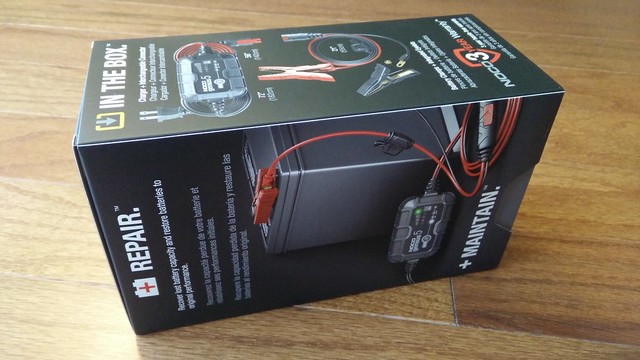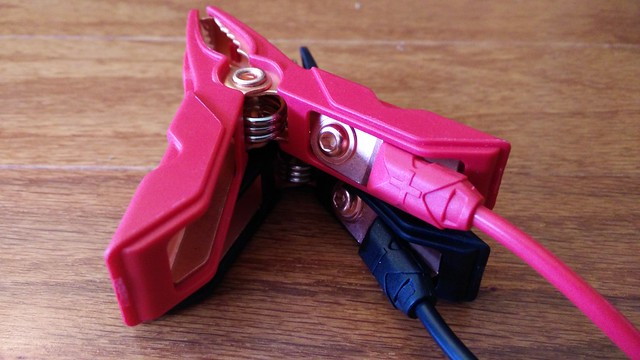NOCO GENIUS - A Practical Review
ℹ️ As an Amazon Associate I earn from qualifying purchases. (details)
NOCO markets their GENIUS line as an "automatic charger, battery maintainer, and battery delsulfator."
A few words about my experience with the NOCO GENIUS line of chargers.
Background
I've used a Battery Tender Junior ($25) the past couple years to keep my motorcycle battery charged while winterized. It provides 750 mA and is only compatible with 12V batteries. For less than $1/month in electricity, the tender monitors the battery voltage and tops it off when needed. I don't have to worry about the bike starting or having to deal with the hassle or expense of replacing the battery had I left it untended.
I haven't been driving as much during the COVID-19 pandemic. I've seen phantom loads draw down the batteries and have had a few times where a vehicle just barely turned over, so after reading some positive reviews I decided to give a few NOCO chargers a try.
My intended usage isn't rapid charging or jump-starting, so I went with two of the smaller and less expensive models that aligned with the battery capacities. Overnight charging and continual tending are fine for me, but if you need faster charging you might want to consider one of the larger models.
Specs
The NOCO GENIUS2 ($42) provides 2 A output and is designed for batteries up to 40 Ah, suitable for smaller car batteries.
The NOCO GENIUS5 ($70) provides 5 A output and is designed for batteries up to 120 Ah, suitable for most car and light truck batteries. That's not to say you can't use a GENIUS2 to charge a larger capacity battery, it'll just take longer at lower current.
Both of these units have numerous modes to support different battery voltages and chemistry:
- 12V - 12-volt wet cell, gel cell, enhanced flooded, maintenance-free and calcium batteries
- 12V AGM - 12-volt AGM batteries
- 12V LITHIUM - 12-volt lithium-ion and lithium iron phosphate batteries; only for use on batteries with a Battery Management System (BMS)
- 6V - 6-volt wet cell, gel cell, enhanced flooded, maintenance-free and calcium batteries
- Force - charges batteries below 1 volt; this mode only runs for five minutes before switching into the standard charging mode
The GENIUS5 also has a Repair mode to repair and recover old, idle, or sulfated batteries. The battery should be disconnected from the vehicle before using this mode, otherwise the higher voltage might damage connected electronics.
The GENIUS line is ETL-listed conforming to UL STANDARD 1236 (Standard for Battery Chargers for Charging Engine-Starter Batteries).
First impressions
Smart and sensible packaging. No blister pack to slice your hands open on.
The exterior shipping box was prominently labeled with the model number and had a sticker (not pictured) indicating serial number. The interior display-ready box arrived sealed in plastic wrap, also labeled with the serial number. The serial number on the device matches that on the packing labels.
The cover slides to the side, revealing the charging unit. The unit was well supported between three pieces of foam, one atop to protect the face and two to the sides protecting the unit from shifting in transit.
The two side pieces of foam lift out, revealing a cardboard platform. The charging unit sits atop and the cabling disappears beneath.
The NOCO GENUIUS5 charger unboxed, with clamp jaws. Not pictured, but there's also a mounting bracket, velcro strap, and a well-written model-specific owners manual.
Build quality is excellent: the units aren't large, but feel solid and hefty.
The Mode button is firm but has an audible and tactile click when depressed. The AC cord is about 4 1/2 feet long and the weather-resistant DC cord is about 5 1/2 feet long, which is good for most of my usage but ten foot DC extension cables ($11) are available.
There are a few anti-skid pads on the bottom of each unit. Model, input and output voltage, and polarity are prominently indicated.
Model: GENIUS5
Input: 100-240VAC 50-60Hz 85W
Output: 6/12VDC 5000mA
Polarity: Red (+), Black (-)
Both units have an IP65 rating, which means dust and the occasional splash of water should pose no issues; you could leave the unit tucked underneath the hood in the rain and have few concerns. The DC cabling appears to be more weather-proof than the AC power cord.
The clamp jaws are wide, springs firm, and handles appear to be well insulated. The eyelets can be removed from the jaws using a hex key, should you want to use a different set of jaws or mount the eyelets directly to a battery. The jaws, eyelets, and wiring appears to be copper.
The included mounting bracket can be used for semi-permanent install within an engine bay or on a shop wall; the bracket is installed with self-tapping screws and a Velcro strap holds the unit in place, positioned in such a way that the mode button remains accessible and charge status display is still visible.
There's no bulky transformer, just a polarized plug. To be fair all of the electronics for the Battery Tender Junior are located within the wall wart itself, but if outlet space is a concern the NOCO GENIUS is definitely more efficient.
Usage
Attach the positive (red) clamp to the positive battery terminal.
Attach the negative (black) clamp to a negative ground point. This assumes a negative ground system.
⚠️ Warning: For safety purposes most manufacturers advise against connecting directly to the negative battery terminal, particularly in modern vehicles. When in doubt, refer to the owner's manual for your vehicle. If accessory usage or charging isn't mentioned explicitly, check the section on jump starting; if those instructions say use a ground point, don't connect directly to the negative battery terminal.
For a more permanent install (and for quicker connect/disconnect), the eyelets can be removed from the included clamps and attach directly to the positive battery terminal and negative ground point; larger M10 eyelet terminals ($12) and M8 eyelet terminals ($10) are also available.
Plug in to AC power. Press the Mode button until the correct battery chemistry LED illuminates. And that's it, you can walk away and let the charger do its thing. To access the Force or Repair modes, you can press Mode for 3-5 seconds respectively before selecting the battery chemistry.
As the battery charges, there's a series of red and orange LEDs that pulse and illuminate to indicate 25%, 50%, and 75% charge, and a large green LED that indicates optimization (when pulsing) and full charge (when solid).
One blurb about the green LED: it can take a long time to change from pulsing to solid (from 75% to full), the bulk of the time spent charging batteries will be spent in this final stage. After the battery is fully charged and the green LED is solid it will flip back to pulsing periodically as needed to provide continuing maintenance.
The LEDs are aligned, sized, and bright enough that you can see the status from across the garage.
There are also a few status LEDs used to indicate various conditions: standby, excess temperature, polarity mismatch, and a defective/bad battery not holding charge.
When you're ready to drive: unplug from AC, disconnect the negative, disconnect the positive, and away you go.
Support
NOCO has been around since 1914 and offers a three year "hassle-free" warranty to the original owner. I haven't had to use the warranty, but three years seems more promising than 30/90/365 days.
Unlike a lot of vendors, NOCO actively answers questions posed by customers on Amazon product pages. It's nice to see official answers from verified manufacturers.
Potential downsides
NOCO units are more expensive than similarly sized units from other manufacturers, but this feels like one of those cases where you get what you pay for.
NOCO doesn't use SAE connectors on their products, instead a proprietary gendered connector called X-Connect. X-Connect is marketed as having "rugged and watertight connectors; solid copper wire and terminals, integrated in-line fuses" and significant strain relief.
I was pleasantly surprised to find the connectors as advertised: beefy, sealed with gaskets, locking connector tabs, actual copper instead of plated nickel or zinc. While SAE is near ubiquitous in the automotive industry, X-Connect doesn't feel like a downside... feels more like a step up.
If you do have a bunch of existing SAE wiring or eyelet terminals on your batteries, an X-Connect to SAE adapter will set you back $8.
Closing thoughts
I'm pleased.
The NOCO GENIUS units are sleek, purposefully designed, well built, provide tactile and visual feedback, support a variety of battery types, and do what they're supposed to do.
I've used the GENIUS2 to charge and maintain the battery in a compact car.
I've used the GENIUS5 to charge and maintain the battery in a pickup truck and to revive a dead Toyota hybrid accessory battery.
Definitely a worthwhile addition to the home garage!
Last Modified: 2020-08-10
§
Home | All Entries | Search | Errata
Copyright © 2014-2024 Alex Moundalexis, licensed under a Creative Commons License. Some rights reserved.










